What Is Tess?
The Transiting Exoplanet Survey Satellite is the subsequent stage in the quest for planets outside our planetary group, including those that could uphold life. TESS will review 200,000 of the most brilliant stars close to the sun to look for traveling exoplanets. On April 18, 2018, TESS dispatched a SpaceX Falcon 9 rocket on board.
TESS researchers expect the mission to index many planet competitors and boundlessly increment the momentum number of known exoplanets. Of these, around 300 are relied upon to be Earth-sized and super-Earth-sized exoplanets, which are universes no more significant than twice the size of Earth. TESS will find the most encouraging exoplanets circling our closest and most splendid stars, providing future analysts with a rich arrangement of new focuses for more complete subsequent examinations.
Approach Of Tess
TESS will overview the whole sky throughout two years by separating it into 26 distinct areas, every 24 degrees by 96 degrees across. The great cameras on the rocket will gaze at every site for no less than 27 days, checking out the most brilliant stars at a two-minute rhythm. From Earth, the moon possesses a large portion of a degree, which is under 1/9,000th the size of the TESS tiles.
The stars TESS will study are 30 to multiple times more brilliant than those the Kepler mission and K2 follow-up overviewed, which will empower far simpler subsequent perceptions with both ground-based and space-based telescopes. TESS will likewise cover a sky region multiple times bigger than that observed by Kepler.
Notwithstanding its quest for exoplanets, TESS will permit researchers from the more extensive local area to focus astronomy research on roughly 20,000 extra items during the mission through its Guest Investigator program.
Transit Methodology
The travel technique for distinguishing exoplanets searches for dunks in the apparent light of stars necessitates that planets cross before stars along with our view of them. Dull, intermittent plunges can uncover Earth or planets circling a star. Travel photometry, which sees how much light an item puts out randomly, can perceive scientists intensely about a world. Because of the amount of a dunk in light a planet causes in its star, we can discover that planet’s size. Considering the amount of time it requires for a world to circle its star, researchers can decide the state of the planet’s circle and what time it needs for the Earth to orbit its sun.
TESS will make an index of thousands of exoplanet applicants utilizing this travel photometry strategy. After this rundown has been arranged, the TESS mission will lead ground-based subsequent perceptions to affirm that the exoplanets’ applicants are valid exoplanets and not bogus up-sides. Utilizing the realized planet size, circle and mass, TESS and ground-based subsequent will actually want to decide the planets’ arrangements. This will uncover whether the worlds are rough (like Earth), gas monsters (like Jupiter), or something significantly more uncommon. Extra development with ground-and space-based missions, including NASA’s James Webb Space Telescope, will likewise permit cosmologists to concentrate on the airs of a significant number of these planets.
TESS group accomplices incorporate the Massachusetts Institute of Technology, the Kavli Institute for Astrophysics and Space Research, NASA’s Goddard Space Flight Center, MIT’s Lincoln Laboratory, Orbital ATK, NASA’s Ames Research Institute and many more.
Who is involved in this project?
With NASA at its core, TESS is a collaboration between astronomers and scientists from MIT’s Kavli Institute for Astrophysics and Space Research; MIT’s Lincoln Laboratory; Goddard Space Flight Center; Orbital ATK; Google Inc.; and top universities across America. Funded by NASA’s Science Mission Directorate, TESS will launch in 2017 to begin a two-year survey mission of our solar neighborhood. During that time, it will monitor more than 200,000 stars for temporary drops in brightness caused by planetary transits. These telltale signs of orbiting planets will be visible to TESS even when their host stars are too far away and too faint for ground-based telescopes to detect them directly. As a result, thousands of new planets outside our solar system—or exoplanets—are expected to be discovered.
![]()
